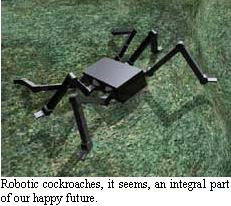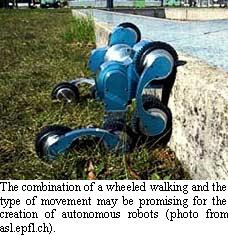 "However, their main goal - creation of the world's first robotic cockroach, which is ..." - this quote from a university press release. Wow, that's because what are the people the main goal! Jokes, jokes, and mechanical cockroaches in their heads, as it turned out, many people. They live a little, eh?
"However, their main goal - creation of the world's first robotic cockroach, which is ..." - this quote from a university press release. Wow, that's because what are the people the main goal! Jokes, jokes, and mechanical cockroaches in their heads, as it turned out, many people. They live a little, eh?In New Zealand there is such a university Massey (Massey University). It is trained three young men with burning eyes - Digel Olaf (Olaf Diegel), Sylvester Tile (Sylvester Thiale) and Podgiter Johann (Johann Potgieter). To ensure that their eyes do not fade away, watching Professor Glen Bright (Glen Bright).
So, what does all this good company, mechatronics - the Japanese name for industry, formed by the merger of general and electrical engineering.
Merging in unison is, we should understand well, after four announced the creation of robotic lawn mowers.
Briefly about the Auto Mower. The perimeter of the lawn enclosed with wire, which mark the boundary area for mowing - leave the territory it has no Roman law. Semikilogrammovaya Auto Mower, although it squints at random, but does it honestly, around obstacles, she knows how to roll on the charging and so on. Whether we kosilschikami lawns - gnawed to the elbows - $ 1,5 thousand.
The point is also that robotokosilka designed not simply on the basis of Auto Mower, and commissioned by Husqvarna - general manager of the company, David Boyd (David Boyd) said that he could not miss the chance to support the study of New Zealanders: "We are still world leaders in production of every kind garden equipment, and our collaboration with the inventors opens new avenues for consumers. "
At Harvard, too, do the robot cockroaches.
Robotic cockroaches (Robotic Cockroach) in New Zealand after 18 years of that kind will be masters of all trades, or what they have there instead of hands would be: "Robot cockroach will assume most of all the household chores. He will be vacuumed, mow lawns, wash dishes, floors and windows, as well as about making the bed. " In short, the mechanical marvel is the antipode of the insect.
However, it is clear that the robot will be artfully arranged: from the "cockroach of the mother" would crawl "cockroaches-children" who will be engaged in any business small things. After five years (from 2007) New Zealand enthusiasts are going to release the first such robot on the market, and in 2020 a robot cockroach come to you.
We seem to have mentioned that the robotic cockroach dream, not only in New Zealand. Robot cockroach length of 4 feet (1 meter and 20 centimeters) is constructed in the laboratory of the University of Illinois (University of Illinois Coordinated Science Laboratory - CSL) in conjunction with the Institute name Backman (Beckman Institute for Advanced Science and Technology). Here's the proof.
Message is called "CSL is developing a cockroach, which you can fall in love:" The oldest and in everyday use the image of the robot - it is a kind of jerry cans on wheels, like R2D2 from Star Wars. "But walking robots have many advantages in front of rolling robots.
For example, they can step over obstacles. That is why the various research centers across the country build a biped and quadruped robots, "- says a professor from CSL Narendra Ahuja (Narendra Ahuja), who with his team working on a six-legged mechanical creature.
| |
Robot cockroach from Illinois. |
The American cockroach robot has a pair of short front legs, a couple in the middle, which keeps the weight, and a couple from the rear for propulsion. For more resemblance to the original insect consulted with physiologists. The robot still sees nothing - sensors in the manufacturing process.
When everything is ready, cockroaches will be the unenviable rabotenka - its going to send and to Mars, and the North Pole - in a word to the maximum extreme - "it is in any better than to find these cockroaches in his kitchen," - joke makers.
While we're laughing, it was found that the Office of Naval Research United States (Office of Naval Research - ONR) has long funded major program, called Biomimetic Robots. In this case, biomimetika - it is an imitation of living organisms, a sort of mimicry machines (Biomimesis: to mimic life, to imitate biological systems).
The purpose of the program "is that, possessing the necessary biomechanical understanding, to create a robotic roach that is appropriate for autonomous action in unstructured environments."
It turns out that in biomimicheskoy program involving such institutions as Stanford (Stanford), Berkeley (UC Berkeley), Harvard (Harvard) and Johns Hopkins (Johns Hopkins). That Stanford portion of the program, that's Harvard, but how do we know about it.
| |
Robotic cockroaches started at Stanford. |
Quote: "Unlike conventional robots, which act very slowly, but accurately, robotic cockroach will move more like a bug: fast, but a bit messy.
Constructed on the basis of studies of insects robots will be able to emulate their structural dynamics, and simple management strategies. They will be able to overcome impassable terrain at high speed. "
What happens? That's right - robot cockroaches for military purposes. Names for combat cockroaches invented relevant - Biobot, Protobot and the like. So, one building cockroaches for washing dishes, while others - those that "we will be able to love, and the third (and maybe all together) - for the war. All, as usually happens with cockroaches: "swallow, swallow, no mercy."





